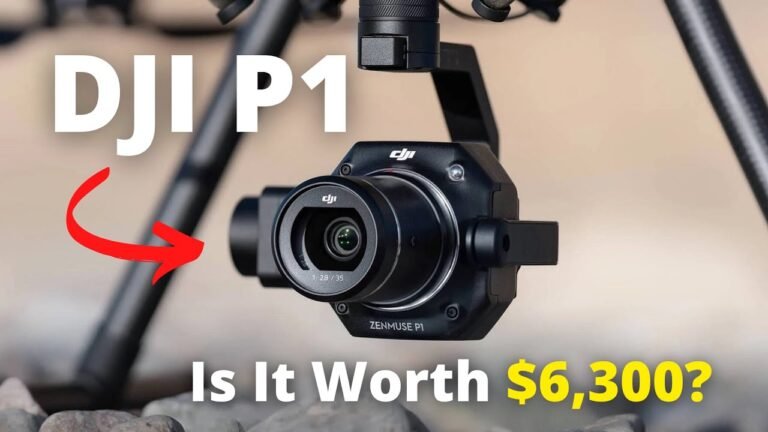
In this informative video by Dylan Gorman, the DJI P1 camera is put to the test against other cameras in DJI’s lineup to determine if it is worth the price tag of $6,300. The video covers various aspects of the P1 camera, including its specifications, capture tests, photogrammetry comparison, and conclusion. As a commercial pilot with expertise in photogrammetry, Dylan Gorman provides valuable insights and recommendations for those who prioritize image quality and require a full-frame sensor for their drone photography needs. The video offers a comprehensive analysis of the P1 camera, making it a must-watch for anyone interested in high-quality aerial photography and mapping projects.

This image is property of i.ytimg.com.
Camera Specs
The DJI P1 camera is DJI’s flagship full-frame 45mp camera designed specifically for photogrammetry. It is equipped with a global shutter and comes with a price tag of $6,300. The full-frame sensor allows for better image quality as more light is able to enter the sensor, resulting in clearer and more detailed images. This is a significant improvement compared to previous options such as the Phantom 4 Pro V2 and the Inspire 2 with the X4S camera, which had limitations in terms of shutter speed and motion blur. The P1 camera’s global shutter ensures better image quality and reduces motion blur, making it ideal for photogrammetry projects.
Capture Test
In a comparison between the DJI Mini 2, the X5S camera from the Inspire 2, and the P1 camera, the P1 camera showcased significantly better image quality. The P1 camera captured a total of 76 photos during the flight test, providing a good balance between the Mini 2 and X5S. The image quality of the P1 camera was far superior, capturing more detail and clarity compared to the other cameras. This test clearly demonstrates the P1 camera’s superiority and its ability to deliver high-quality images.
Photogrammetry Comparison
The DJI P1 camera is particularly ideal for large-scale mapping or photography projects. Its full-frame sensor and image quality make it an excellent choice for capturing hundreds or thousands of acres per day. For those who prioritize image quality and require a full-frame sensor for their drone photography needs, the P1 camera is highly recommended. Furthermore, the author provides links to data sets for further analysis and comparison, allowing users to delve deeper into the capabilities of the P1 camera.
Time Saving and Cost
One of the significant advantages of using the DJI P1 camera is the time savings it offers in camera and drone setup. Comparing flying with the Inspire 2 and X5S camera to the M300 and P1 camera, the author found that the latter combination saved a significant amount of time. In a test, flying with the M300 and P1 camera took 2.5 hours and 2200 photos, whereas flying with the Inspire 2 and X5S camera would have taken 7 hours and 7000 photos. This time-saving feature is especially crucial for large-scale projects where efficiency is key.
While the cost of setting up the P1 camera and extra batteries may be higher, the flight time and data capture capability of the M300 make it a worthwhile investment. The P1 camera offers a flight time of 45 minutes compared to the 22 minutes of the Inspire 2 with the X5S camera. This longer flight time enables users to capture more data and cover larger areas, making the P1 camera an excellent choice for those with extensive mapping and photography projects.
Suitability for Different Projects
It should be noted that the DJI P1 camera may not be worth the investment for smaller scale mapping or photography projects. In these cases, it is more practical to stick to the Inspire 2 with the X4S or X5S camera options. The P1 camera’s high-quality imagery is not necessary for smaller projects, and it is more efficient to fly lower and slower to achieve the desired results. Understanding the scale and scope of your project is essential in determining whether the P1 camera is the right choice.
Conclusion
In conclusion, the DJI P1 camera receives positive feedback due to its outstanding image quality and capabilities for large-scale mapping and photography projects. The full-frame 45mp sensor coupled with the global shutter ensures improved image quality and reduced motion blur. However, it is important to consider the scale and budget of your project before investing in the P1 camera. For smaller projects, the Inspire 2 with the X4S or X5S camera may suffice. Overall, the P1 camera is a reliable and powerful tool for professionals in need of high-quality aerial imagery.
If you found this article helpful, be sure to like and comment for more informative videos.
In this video, we will be taking a closer look at DJI’s flagship Full Frame 45mp camera, the P1. We will be comparing its performance to the x5s camera from the Inspire 2 and the DJI Mini 2 in a photogrammetry test to determine how well it performs.
If you’re interested in the drone industry, we invite you to join us on Pilot Byte! Our platform provides information and resources for current and aspiring drone operators to promote growth and development. You can visit us at: Pilot Byte
For those who want to dive deeper into the topic, we have provided some resources for you to explore:
If you are a beginner and looking for a drone recommendation, here are a few options to consider:
- DJI Mini 2 – Perfect for beginners.
- DJI Air 2s – Another great option for beginners.
- DJI Inspire 2 – Ideal for those at an intermediate level.
- DJI Mavic 3 – Another intermediate-level option.
If you enjoy this content, don’t forget to subscribe to my channel: Dylan Gorman
—
Here is a list of my camera equipment that I use for filming:
—
Don’t forget to follow me online for more updates:
—
If you’re interested, here are the chapters covered in this video:
- Aerial mapping
- DJI P1 workflow
- DJI Zenmuse P1 camera
